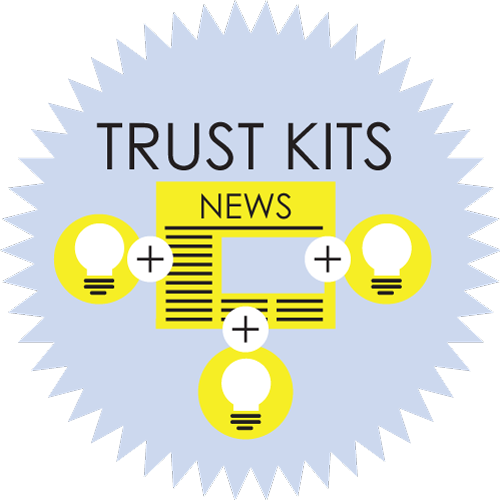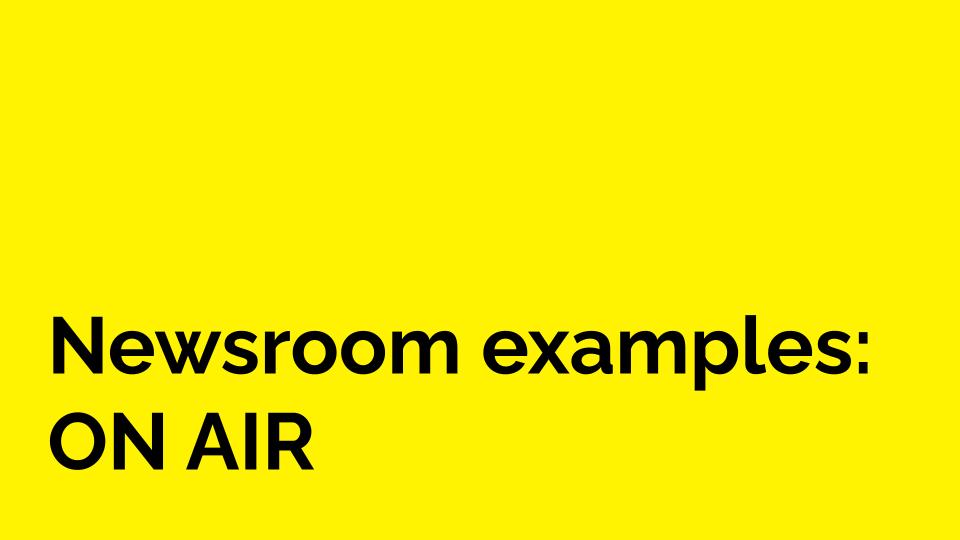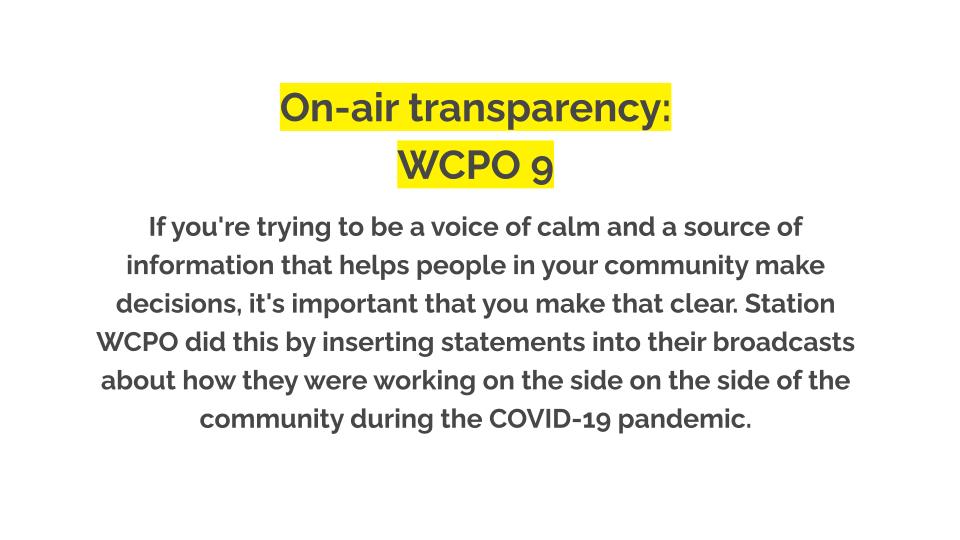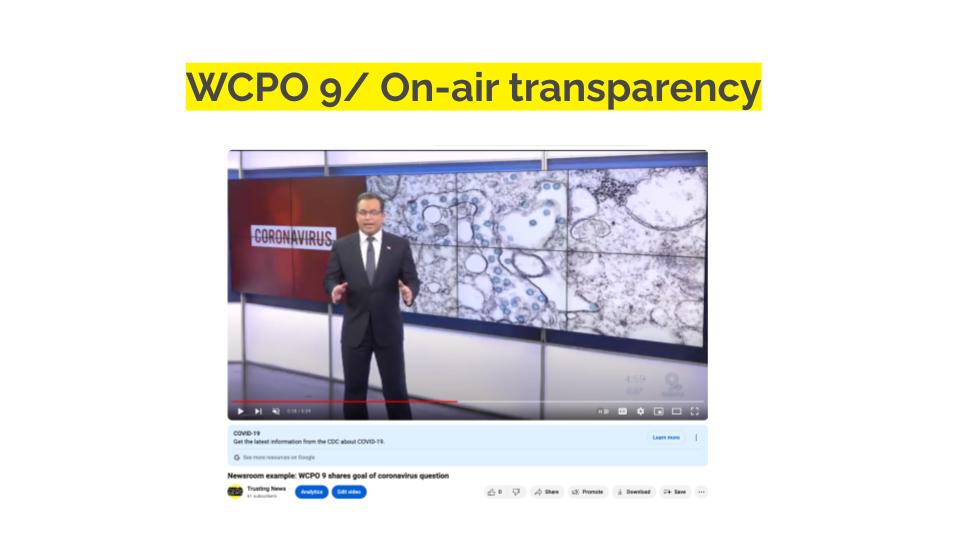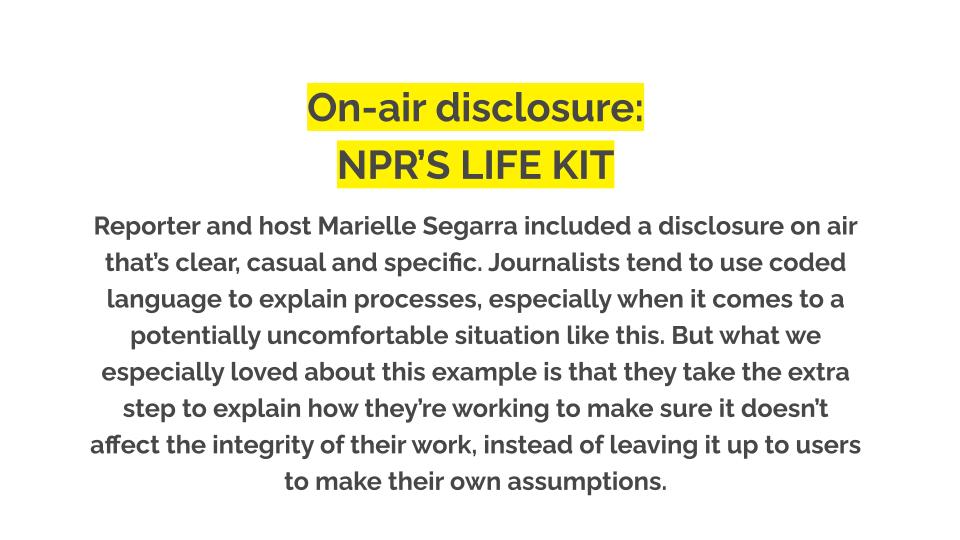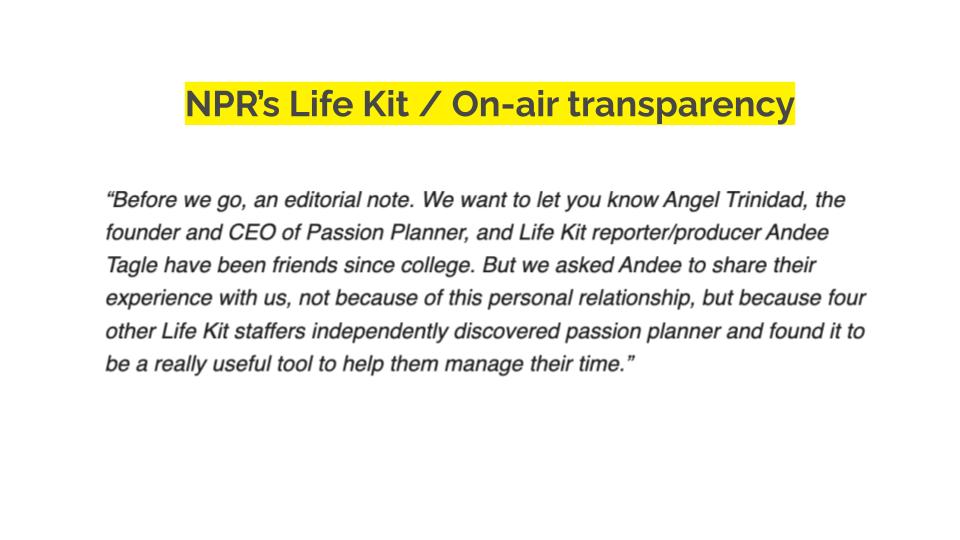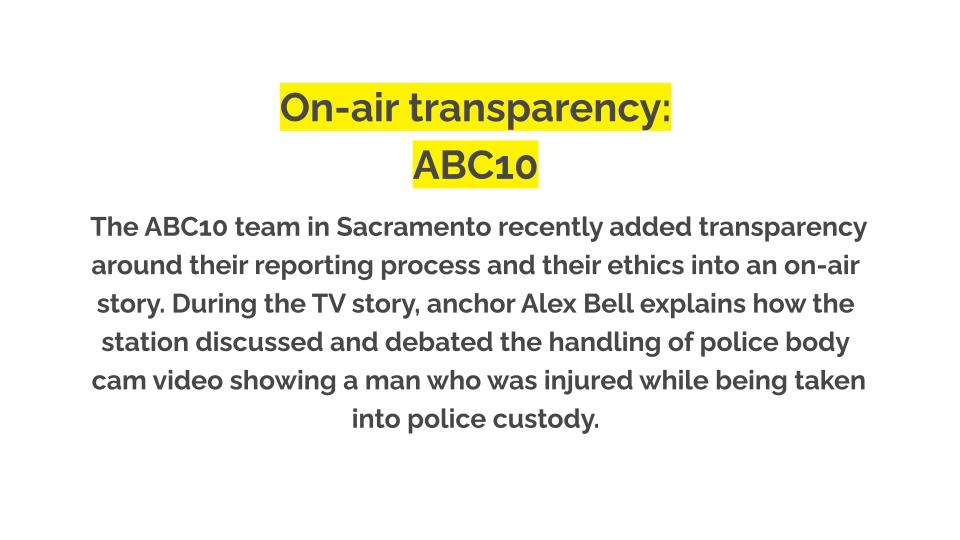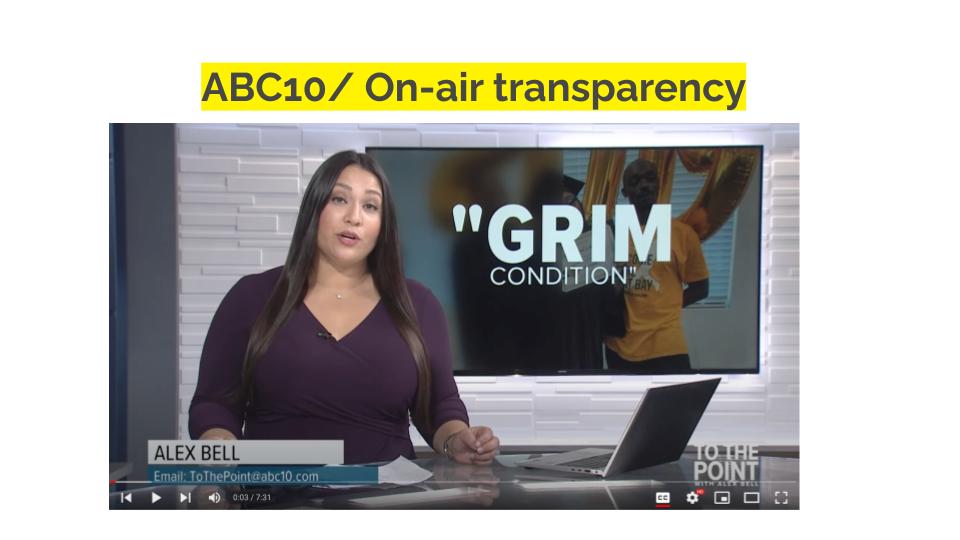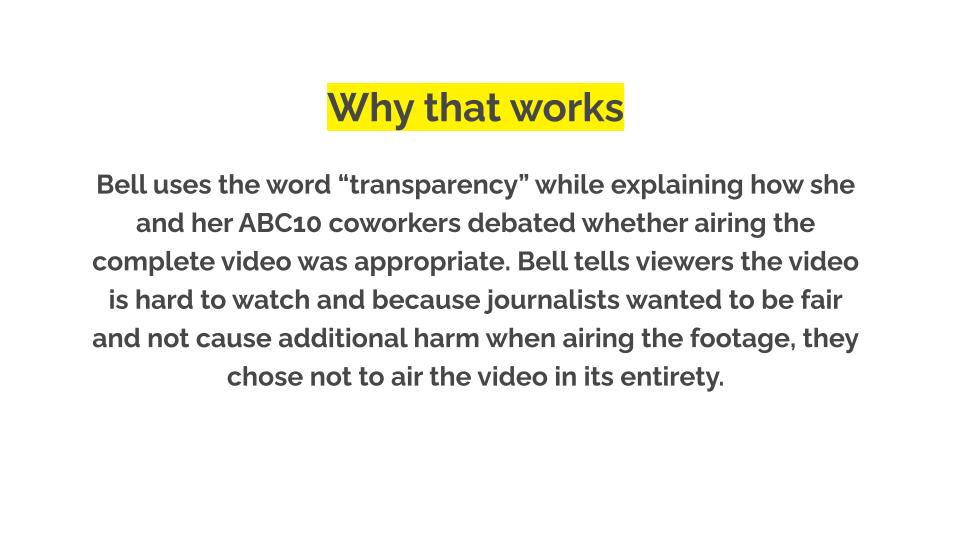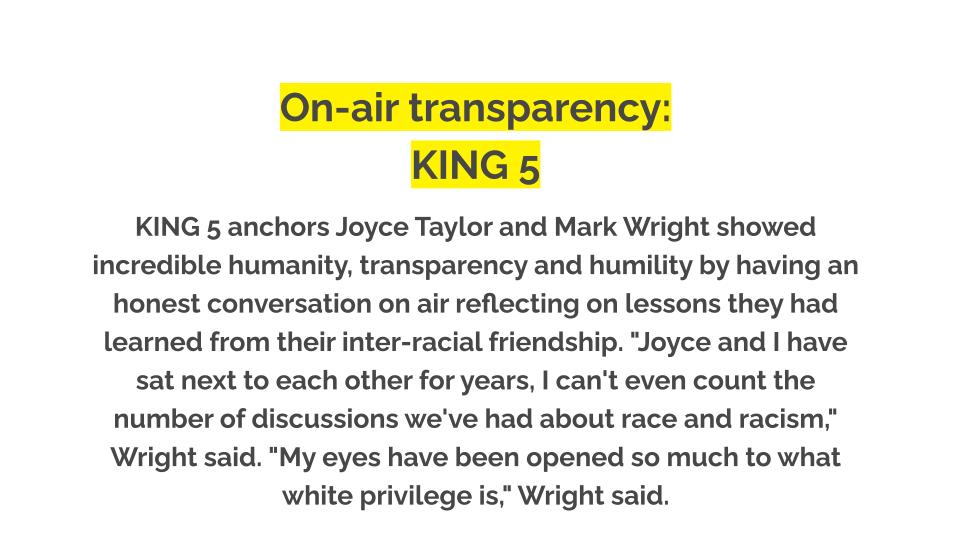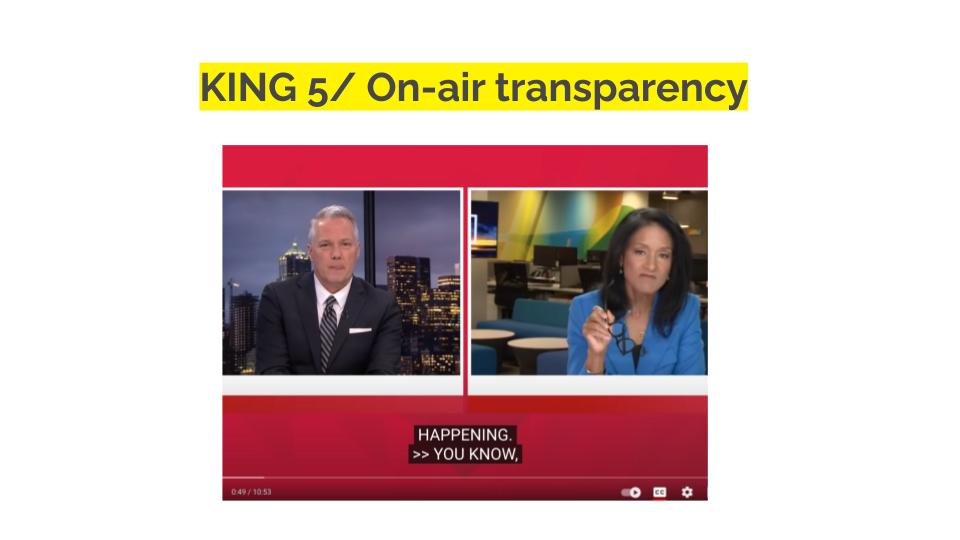Building trust on air
Building trust in local TV newsroom content is pivotal for nurturing a thriving democracy and fostering civic engagement. Local news outlets serve as vital sources of information, shaping citizens’ understanding of local governance, elections, and community issues.
When TV newsrooms maintain credibility, they empower people to make informed choices and actively participate in civic affairs.
The audience is there: More people get news from TV than from radio or print. And when it comes to access to news across diverse communities, it’s also true that local TV is more preferred by people of color in the U.S. than newspapers or digital-first local news. It’s free, and it’s widely available.
So, how can TV newsrooms build trust? The good news is we have research that shows it’s not that different from other advice we provide related to transparency, engagement and listening. The main difference is how you do it and using the broadcast formats to tell the story in a way that relates to the audience and gets your message across without sounding too self-promoting or interrupting the story flow.
A note about audio and visual platforms more generally: While this Trust Kit focuses on TV news, most of the strategies here would work well on radio as well, and many are also useful for social media videos.
Building trust through local TV coverage is pivotal for nurturing a thriving democracy and fostering engagement.

Goals
This Trust Kit helps you:
- Learn why building trust with on-air coverage is important and why it works
- Understand where trust elements work best in on-air content (for TV and radio newsrooms)
- See scripts for stories where trust elements have been added
- Learn how to explain ethical decisions around video content
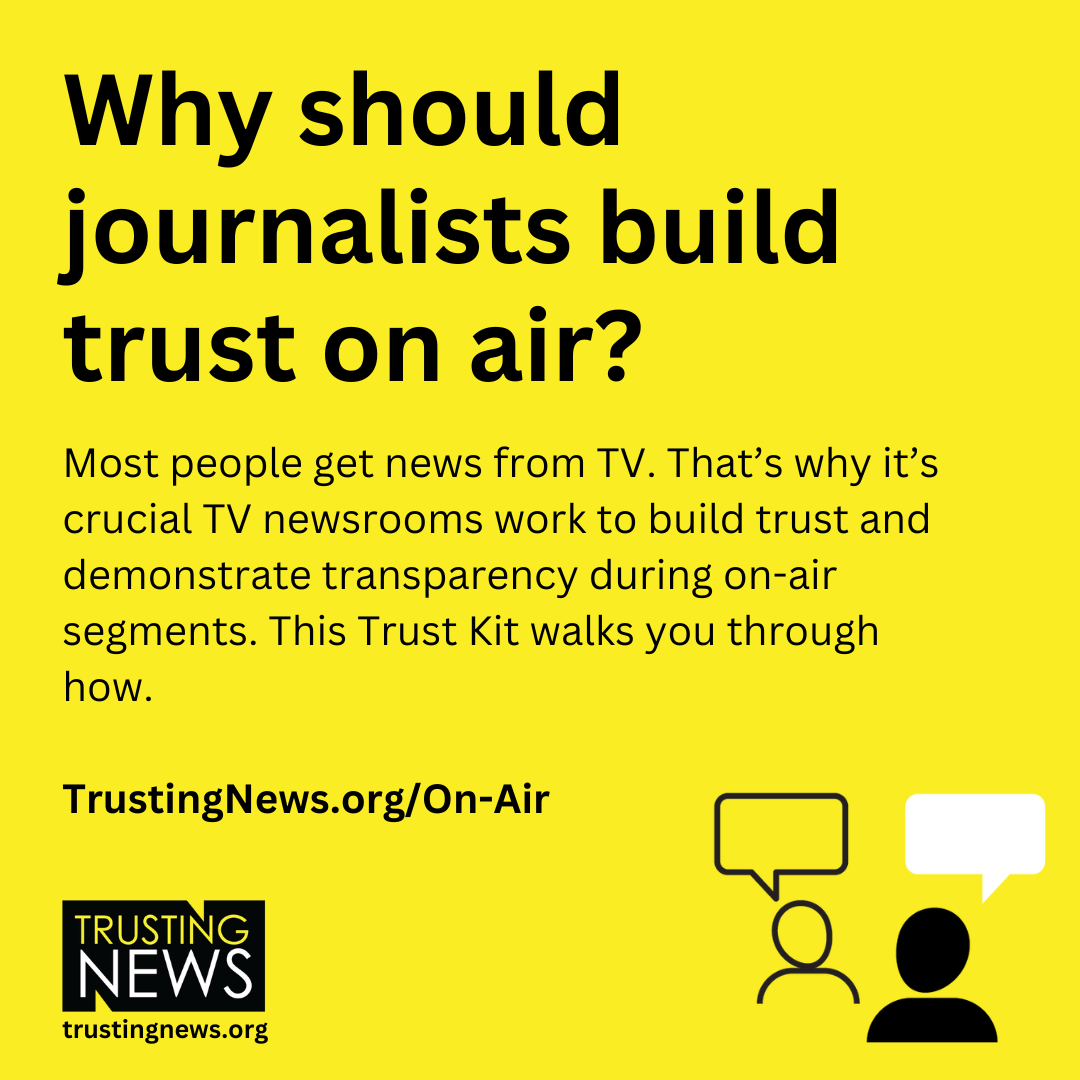
Want more guidance? Watch the below 20-minute training that walks you through the strategies in this Trust Kit.

It works! Research around building trust on air
Through a series of focus groups, Trusting News and the Center for Media Engagement found that TV newsrooms can build trust with their audiences by explaining why a story is covered, providing additional resources at the end of stories and inviting audience participation.
The focus groups featured news content from WCPO, an E.W. Scripps-owned station in Cincinnati and a Trusting News newsroom partner. The goal of the focus groups was to determine how TV news audiences would perceive the addition of the following trust elements:
- An introduction that described how and why the story was reported
- Information that encouraged audience participation or provided resources at the end of the story
- A description of the station’s overall mission for the story, provided in the middle of the report (for example, explaining that the station covered a story about a police officer’s arrest because he is in a position of power in the community)
The focus group participants compared two versions of the same story and discussed them at length. They watched news clips from actual WCPO broadcasts. They also watched a new version of each story that included the trust elements mentioned above, which the station’s journalists created with support from Trusting News.
“Participants noted that the news clips with trust items seemed more complete and relatable,” the research found. “Several participants used phrases such as ‘personal connection’ to describe why they preferred these versions of the clips, even though they could not immediately identify what was different about them.”
According to the Center for Media Engagement, the results suggest that news stations should do the following three recommendations.
Explain why the story is being done and make it clear why the explanation is being provided.
For the reworked stories, WCPO used Trusting News strategies to add language to the beginning that explained what the story was going to be about and why the coverage of that story was important.
For one story, the introduction explained it was a “story about local people sharing their personal experiences to help others.” According to the research, “people who liked these explainers saw them as a way for the station to explain why they were doing the story.”
One focus group participant noted this part of the story made her feel like WCPO cares about her community. “For me, it made it feel like they were talking specifically to me. Like, ‘Hey, I want you to know what’s going on. I want you to know what happened in this story, and here are the facts,’” she said. Another said the explanation would make him trust the TV station more. “They’re hitting all the bases,” he said. “They’re explaining why — they clearly state their mission. Clearly state the reason for the news story, and all those things are kind of like trying to build rapport with the person that are the audience. So yeah, I would definitely trust them more and would watch them more.”
Encourage audience participation or provide additional resources after the story.
At the end of the news stories, Trusting News added information to encourage feedback or provide additional resources related to the story’s subject matter.
One story included an email address and phone number so people could contact the TV station about future community events. In the police officer story, viewers were provided with a domestic abuse hotline number.
According to the research, “in both cases, participants felt this addition improved the story, and, in some cases, made them trust the station more …Multiple participants noted that the domestic violence hotline number was helpful for the police officer story, and it made them feel they trusted WCPO more.” One focus group participant said: “I like that they — at the end of the second video — they opened it up kind of to the community. Hey, what do you want to know about? We’re not going to just keep telling you or shoving information down your [throat]. Tell us what we want — what you want to know about?”
Keep these trust items brief and to the point.
The research showed that a minority of the focus group participants thought the trust elements added unnecessary information. While it was a minority that felt this way, it is worth noting that when adding trust elements to an on-air product, it is recommended to keep the trust elements brief and to the point.
It is also worth noting that not every story you produce may need a trust element. When thinking about when to add these layers of transparency, focus on stories where you can explain an ethical decision you made or talk about why it’s important to report on the story in the first place.
Try to anticipate what pushback or misassumptions viewers might make about the story, and proactively address them. Then keep the language direct and to the point.
Additional research
A recent research project the Radio Television Digital News Association (RTDNA) conducted with Magid dove deeper into trust in local TV news. According to the research, “if just one journalist from a local news source is not trusted, audiences are overwhelmingly less likely to use the source overall.”
Based on this research. RTDNA and Magid divided their recommendations for local TV journalists into four categories:
- Be Right: News consumers trust journalists when they explain how stories developed and changed over time.
- Be Your Community. News consumers trust journalists who are knowledgeable about the local community and what issues are important to them.
- Be Real: News consumers trust journalists when they are authentic, genuine and own up to a mistake.
- Be Objective: News consumers trust journalists who leave personal opinions out of news coverage. (Note: At Trusting News, we embrace the spirit of independence and fairness behind this point but also see how “objective” can be used to pretend journalists’ own lens on the world do not influence their work.)
These solutions echo what Trusting News is learning and testing. See how these recommendations can be used to build trust with an audience on air, online, on OTT and on social media below. (More tips and ideas associated with RTDNA’s recommendations can be found here.)
Be right
Explain why you use certain sources. A great way to show your audience you think carefully about the information you share is to explain your use of sources. Explain why you choose to talk to an individual, what their credentials are and what you were hoping to learn from them. Consider using graphics on air to show an individual’s expertise. Also, consider talking about the sources who didn’t make it in your story, but you spoke to for perspective and context, and don’t forget about explaining the use of anonymous sources. Another idea, in this example, a reporter for the Christian Science Monitor shared how she was able to get in touch with students she quoted in her article. You can also explain how you tried to reach a source.
Tell your audience what you don’t know. By being upfront about things that aren’t yet known, journalists can remove some speculation and assure their audiences they’re continuing to ask the important questions. This is especially important when covering big, controversial stories — like elections, public health crises and protests. Consider using graphics and interactive screens to break this content out on air. More tips on how to do this are here.
Explain the reporting process. We know this works. We call them “explain your process boxes,” (other newsrooms call them background cards, nerd boxes, etc.) and we have research showing this works in print and on air. You can explain how you get documents, the cost of documents, why you did a story, etc. Here is a handout to show you what these transparency elements could look like.
Be your community
Tell your community you are there for them. One of the first elements of building trust we explain to newsrooms is people are not giving you automatic credit for being careful or thoughtful. They also are not automatically giving you credit for some core journalistic beliefs like being a public service. If you want them to know you care about the community and helping them, you have to tell them. Check out how WCPO does this on its about page and review this Medium post for step-by-step guidance on how to create an effective “About Us” page. Be sure to connect with your creative services team too, to make sure the messaging attached to news stories reflects what is seen in promos.
Hiring needs to reflect the community. We have to do a better job of having the people in our newsrooms reflect our community. This is true on all levels: race, sexuality, ethnicity and other aspects of life like religion, military experience, socioeconomic status, education levels, etc. We worked with newsrooms to create a hiring guide we think can help with this. Something else to think about: we may have to be flexible about the qualification requirements we have. If someone is a trusted source in the community or from the community but doesn’t have a college degree, are we willing to train them on journalistic principles and still hire them?
Go into your community. If we want to understand the community we have to know who they are. What if journalists spend a day a month in a specific area of your community with the purpose of talking to people? Not for a story, but to hear from them and visit with them. It’s important when we do this that we reach real people. Not people we use as sources (local activists, church leaders, etc.) but people we normally do not talk to or engage with.
Be real
Talk about your mistakes and make it easier for people to tell you about them. We don’t like to get things wrong and we work hard to prevent mistakes from happening. But, sometimes they still do. Be honest about mistakes and what you’re doing to prevent them. Also, get on the record about how hard you work to get things right. Read more about why this is important in this Medium post (it also includes examples of how newsrooms are making their corrections policies public and tools to make it easier for people to submit corrections to you.)
Make it easy to contact your reporters. Update staff bios and make sure they are easy to find. Consider including contact information on stories and consider reporter mission statements.
Look for opportunities to introduce your journalists. Use social media and other content like newsletters to show your audience who’s behind your journalism. Check out how the Philidelphia Enquirer did this and how The Day did this on social media and through videos from staff.
Have humility and show compassion. If we want people to trust us we have to be willing to meet them where they are sometimes. When it comes to news, that means showing compassion for the news consumption experience. It’s confusing and frustrating at times. Keep that in mind when responding to the community, especially when addressing their complaints, questions and criticisms. KING 5 anchors showed humanity, humility and compassion in this on-air exchange. Review this for tips on responding in person to common criticisms from community members. You can also build trust by helping them navigate the news.
Talk about your connection to the community. If you are from the area, share that. When talking about the stories you cover, if it’s something you are seeing in your neighborhood or at your kid’s schools consider sharing that too. Journalists are sometimes seen as being from the outside, if you aren’t try to share that when it’s appropriate.
Be objective
(Note: At Trusting News, we embrace the spirit of independence and fairness behind this point but also see how “objective” can be used to pretend journalists’ own lens on the world do not influence their work.)
Word choice is important. A single word can make a sentence or headline take on a whole new meaning. Words also have connotations that can easily suggest bias or opinion. Read more about why paying attention to word choice can help you reach more of your community. Review this for some words to think carefully about before using.
Avoid generalizations. As journalists, we probably don’t mean to contribute to the polarizing world we live in but we are. One way this happens is by overgeneralizing and trying to fit everyone into specific categories. Read more about how to prevent this so we can stop contributing to polarization.
Change the culture of editorial meetings. What if everyone in the newsroom felt comfortable talking openly about their apprehension of the direction a story was going in or the selection of a story to cover in the first place? Or felt comfortable enough to say they shouldn’t cover a story because their opinion of the subject would get in the way? At Trusting News we think a newsroom culture where people feel comfortable weighing in on stories based on their life experiences can create newsrooms with more diversity. If we can be more diverse, we can better reflect our communities and produce content that provides more context and perspectives. (Related tip: invite the community to your morning news meetings.)
Label or eliminate opinion content. Local TV news doesn’t tend to have a lot of opinion content but if you are running any (on any platform) make sure it is labeled properly. The idea of eliminating opinion content altogether came up at RTDNA22 too. This is something more newsrooms are discussing.
Ask for input before, during and after the reporting process. By asking for input and feedback you are able to include more angles and perspectives (some of which you may have missed if you didn’t ask the community.) Review these examples for inspiration on how to do this.

How to build trust on air
We find adding trust elements to on-air content works best by doing the following:
- Adding it to an anchor or reporter intro
- Adding it to an anchor or report tag
- Creating an opportunity for a cross-talk or Q&A period with a reporter/anchor
Take a look at how this can work with the stories involved in the research described above. Below are the scripts for the stories. The underlined text is what was added by Trusting News. (Note: these scripts and strategies could work well in radio programming as well!)
You can look at more examples of the scripts and stories used in the research here.
STORY: CLIFF EFFECT
ANCHOR INTRO
NOW, A STORY ABOUT LOCAL PEOPLE SHARING THEIR PERSONAL EXPERIENCES TO HELP OTHERS.
REPORTER LUCY MAY EXPLAINS HOW A LOCAL ORGANIZATION IS GIVING WOMEN WHO HAVE EXPERIENCED POVERTY THE POWER TO HELP OTHER WOMEN OVERCOME IT.
PKG
THESE DAYS MARY MOSS IS A SUCCESSFUL COMMERCIAL REAL ESTATE PROFESSIONAL.
SHE WORKS AT THE GE BUILDING ON THE BANKS.
BUT SHE REMEMBERS THE STRUGGLE GETTING TO THIS POINT, WHERE EVEN THE SMALLEST RAISE ACTUALLY COST HER MONEY BECAUSE IT MEANT SHE COULD NO LONGER RECEIVE GOVERNMENT ASSISTANCE.
(SOT)
Mary Moss, property assistant, NAI Hiffman: (2:02:56 – 2:03:09 on SKW-6428_01) “You want to advance, you want to move up, you want to make more money. But if I get one dollar raise then, oh no, I’m going to lose my health insurance or I’m going to lose my child care vouchers.”
(LUCY STANDUP)
(2:41:46 – 2:41:56 ON SKW-6432_01) “When someone loses more money in benefits than they gain from a pay raise, that huge financial drop is called the cliff effect.”
(VO)
AT WCPO WE WORK TO GATHER THE MOST COMPLETE INFORMATION AVAILABLE ABOUT THE ISSUES IMPACTING OUR COMMUNITIES, ESPECIALLY WHEN WE HEAR ABOUT SITUATIONS LIKE THIS THAT MIGHT BE SURPRISING TO VIEWERS. SO, WE SPOKE TO THE WOMEN’S FUND OF THE GREATER CINCINNATI FOUNDATION WHICH STUDIES THE CLIFF EFFECT.
(SOT)
Meghan Cummings, executive director, Women’s Fund: (2:26:44 – 2:26:57 ON SKW-6430_01) “A lot of times what we see is even someone gets a raise, maybe even just $2,000 a year, it could trigger a public benefit cut off of about $14,000 a year so that raise didn’t make them any better off.”
(VO)
CUMMINGS SAYS THE WOMEN’S FUND DECIDED TO ENLIST WOMEN LIKE MOSS – WHO HAVE LIVED THE CLIFF EFFECT – FOR A NEW ADVISORY COUNCIL.
THAT COUNCIL DECIDES HOW TO DISTRIBUTE $50,000 IN GRANTS TO LOCAL NONPROFITS THAT HELP WOMEN WHO ARE WORKING TO BECOME SELF SUFFICIENT.
(SOT)
Meghan Cummings, executive director, Women’s Fund: (2:28:55 – 2:29:05 ON SKW-6430_01) “We thought it was really important that we ground our work in the experience of these women, and how can we respond to that through all parts of our mission, especially in our grantmaking decisions.”
(VO)
MOSS IS ON THE ADVISORY COUNCIL.
A MOTHER OF THREE, MOSS HOPES TO HELP OTHER WOMEN FIND A SMOOTHER PATH THAN SHE TRAVELED.
(SOT)
Mary Moss, property assistant, NAI Hiffman: (2:08:17 – 2:08:30 on SKW-6428_01) “Those, let’s say, who haven’t experienced what I have or maybe they are going through it, I’m someone that can help them. I’m someone that can give them that knowledge, that can guide them, can answer their questions.”
(VO)
MOSS SAYS THOSE PERSONAL CONNECTIONS CAN BE THE BIGGEST HELP OF ALL.
LUCY MAY, NINE ON YOUR SIDE.
ANCHOR TAG
COVERING ALL OF OUR COMMUNITY IS A PRIORITY FOR US AT WCPO.
IF THERE ARE PROGRAMS, EVENTS OR STORIES YOU THINK THE COMMUNITY SHOULD KNOW ABOUT, LET US KNOW.
WE HAVE A FORM ON OUR WEBSITE WCPO.COM OR YOU CAN ALWAYS MESSAGE US ON SOCIAL MEDIA, SEND US AN EMAIL AT NEWSDESK AT WCPO DOT COM OR GIVE US A CALL AT 513-852-4071.
Watch the segment below:
STORY: LEBANON OFFICER
ANCHOR
NEW AT 5 — A LEBANON PATROL OFFICER HAS BEEN ARRESTED FOR DOMESTIC VIOLENCE.
VO
THE LEBANON POLICE CHIEF TELLS US OFFICER JOHN WETZEL WAS ARRESTED BY CLEARCREEK TOWNSHIP POLICE LATE SUNDAY EVENING.
HE’S ACCUSED OF LOADING A SHOTGUN WHILE INTOXICATED AND MAKING THREATS AGAINST HIS WIFE AND HER BOYFRIEND.
THE OFFICER WAS OFF-DUTY AT THE TIME.
LEBANON’S POLICE CHIEF SAYS WETZEL IS ON ADMINISTRATIVE LEAVE… PENDING AN INVESTIGATION.
ANCHOR
AT WCPO WE THINK CAREFULLY ABOUT WHAT CRIME STORIES WE COVER.
BECAUSE THIS INVOLVED A POLICE OFFICER, SOMEONE WHO HAS POWER AND AUTHORITY IN OUR COMMUNITY, WE FEEL IT IS IMPORTANT FOR THE COMMUNITY TO KNOW WHEN THEY ARE INVOLVED IN VIOLENT CRIMES.
TO LEARN MORE ABOUT OUR CRIME COVERAGE POLICY VISIT WCPO.COM/CRIME
ANCHOR
ALSO, IF YOU OR ANYONE YOU KNOW ARE EXPERIENCING ABUSE IN A RELATIONSHIP PLEASE CONTACT THE DOMESTIC ABUSE HOTLINE 1-800-799-7233.
Watch the clip below:
An example: Explaining ethical decisions on air
ABC10 in Sacramento showcased its reporting process and ethical decision-making in an on-air segment. Anchor Alex Bell discussed their deliberation over airing police body cam footage depicting a man injured during an arrest. In the segment, Bell emphasized transparency, explaining the station’s decision-making process. They opted not to air the full video on TV due to its distressing nature, aiming to be fair and avoid causing further harm. She highlighted consultations with their internal race and culture team along with mental health experts before making this choice. The complete video was, however, available on their website.
This story is great for so many other reasons as well, including:
1. They don’t wait to be transparent.
The journalists didn’t just add on a bit about trying not to cause harm at the end of the story. The story actually begins with Bell taking time to set the story up. She provides context and an on-ramp for viewers. This means, even though I may not know anything about this man, his family or this incident, I am able to understand and consume the news content without being confused or thinking I missed something (and then turning the channel or moving on to the next YouTube video). She also provides a warning that some people may find the video hard to watch.
2. There is so much care taken throughout the story.
Before we even see the reporter package (main TV story with sound bytes and information), there is a thoughtful and helpful setup from both Bell and the reporter, Becca Habegger. Habegger explains who she has been talking to and where she talked to them and clearly explains what the focus of the story now is: the man’s family wants accountability from law enforcement and more answers.
3. They didn't rush the story.
Often, stories involving crime and police are boiled down into short clips. This results in most of the nuance of a hectic and potentially dangerous situation being left out. That leaves viewers to fill in the void with their own assumptions — about you and your trustworthiness but also polarizing and inaccurate stereotypes about the sources or subject matter.
4. They didn’t sensationalize the story.
Too often when there is body cam footage, it’s teased with “breaking news” banners, fast camera movements in the studios and more. It becomes sensationalized. The fast-paced script, camera movements, editing and flashing images seem to encourage excitement and anxiety.
5. They address possible assumptions and feelings directly.
The reporter and anchor discuss how some people may side with the police and accuse the station of taking the man’s side of the story. They address that allegation head-on with Habegger saying we know people will have different opinions about this and then reads a quote from the family about that accusation.
You may watch the story and think, this is just careful, responsible and ethical reporting. What’s so special about this? I agree. The team was careful. They were thoughtful. They thought about harm and worked hard to minimize it. That’s what good reporting is. That’s what we all should be doing, right?
But that’s not what we typically see, right? Coverage of issues like this is often rushed. It causes damage to our community and our relationship with our audiences. (Related resource: Reinvent your crime coverage to build trust.)
This example shows it doesn’t have to be that way, with digital stories or on air. We can add transparency elements to a TV story and still tell an engaging story. They did this and you can too, by:
- Providing context or an on-ramp to an anchor or reporter intro
- Not being afraid to add a cross-talk or Q&A between journalists to help set the story up (add context), explain your motives or goals in reporting the story, explain ethical decisions, etc.
- Using the anchor or reporter tag to talk about how you were careful and what you discussed or debated while reporting the story.
- Anticipating how your viewers might respond and addressing those responses directly
- Not being scared away from adding context because of story time limits or traditional tv producing styles

Other ethical considerations
Editing video
Some things to think about when editing video:
You’ve probably heard the criticism or accusations before: You edited that photo to purposefully not show the whole scene, or you purposefully cut the video before they made their point.
Accusations like these are all too common, and it won’t surprise you to know that our advice is to address them publicly. Be proactive about explaining your decisions, and defend your integrity on the record.
Questions about the ethics of visual journalism have sometimes seemed even more prevalent during the pandemic. And when faced with criticism or accusations, some journalists have responded. Instead of leaving them to wonder, what if we answered some of these questions:
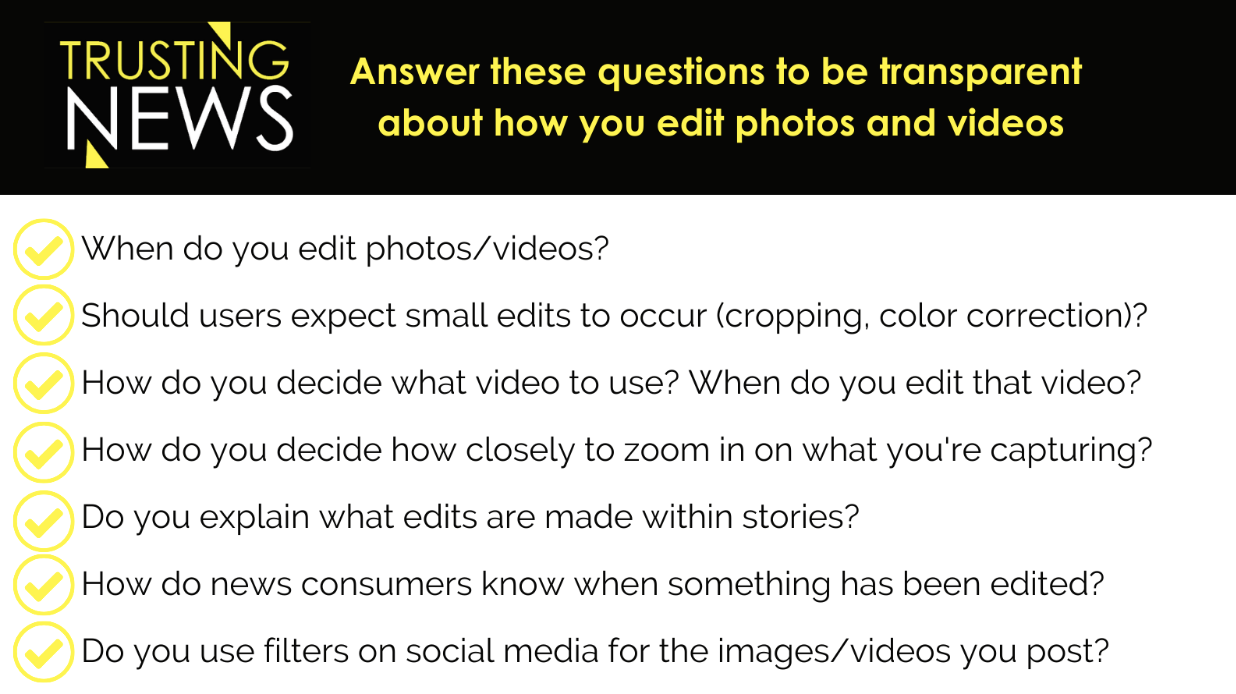
A standard set by the National Press Photographers Association (NPPA) code of ethics related to editing says, “Editing should maintain the integrity of the photographic images’ content and context. Do not manipulate images or add or alter sound in any way that can mislead viewers or misrepresent subjects.”
This is a great start to help answer some of those questions above. Remember, just talking about and making news consumers aware you are thoughtful about the work you do and the decisions you make can help build trust. If newsrooms even just started by saying they follow the standard set by NPPA, I think that would be a good first step.
Where video comes from
When journalists tell stories through visuals, we have a lot of options for where to turn. We routinely shoot photos and videos as part of our daily coverage, of course. But we also turn to our archives, run images from social media and rely on visuals from sources.
Our selection process often involves a lot of careful and thoughtful decisions by multiple people in a newsroom. We weigh which visuals tell the story most effectively of course. And we consider legal consequences involving copyright and fair use. We think about ethical consequences like how people in the photos or video may be impacted or if the visuals are appropriate to share publicly at all.
Some ways we can be consistent with explaining visuals:
- Make sure visuals from the archives and file footage are always labeled as such. A user should know when they are looking at something that wasn’t captured as part of the story it’s associated with. Adding dates and locations is important as well.
- Commit to writing captions that describe what is in the photo/video as well as making a connection between why it’s relevant for the story it’s associated with. In most cases, that connection is pretty obvious, but sometimes an explanation is needed to help news consumers connect the dots. Larry Kutner, a Trust Tips subscriber and former TV news reporter/producer, wrote in and put it this way: Does the audience have the ability to derive the context for the use of the visuals? Do the visuals serve a purpose or are they simply “good video”?
- Be clear about who took the photo or recorded the video. If it was recorded by someone in your newsroom, make that clear (and a name alone is not enough — say “Jeff Smith, ABCD Photojournalist”). If it came from social media, be sure that is clear. (Even better, link to an explanation about why you sometimes use photos from social media, how that process works, how you fact-check content and how people can submit their own photos/videos.)
- If something is graphic or explicit, make sure the proper labels are on the content, everywhere it is used.
See how other newsrooms do it
For inspiration, here are some examples of how newsrooms are building trust on air. For more newsroom examples, check our our newsroom example database.

We’re here to help!
Congratulations on getting this far in the Trust Kit! We know taking the steps to earn trust isn’t always simple or easy. It takes time and often requires a shift in newsroom routines or workflows.
Any progress you make on implementing strategies in this Trust Kit should be celebrated as a win!
